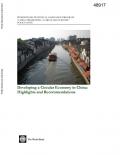
This briefing note highlights and recommends further actions the government should take to enhance the effectiveness of its efforts to develop a circular economy.

The report, From Niche to Norm, provides the experts' view on the opportunities offered by a 'systemic approach to eco-innovation and circular economy' in terms of jobs, growth, and resource efficiency in Europe.

Using product case studies and economy-wide analysis, this report, Towards the Circular Economy: Economic and business rationale for an accelerated transition, details the potential for significant benefits across the EU.

The report, Towards the Circular Economy: Opportunities for the consumer goods sector, focuses on fast-moving consumer goods, which currently account for about 60 per cent of total consumer spending, 35 per cent of material inputs into the economy, and 75 per cent of municipal waste.

Towards the Circular Economy: Accelerating the scale-up across global supply chains, finds that over US$1 trillion a year could be generated by 2025 for the global economy and 100,000 new jobs created for the next five years if companies focused on encouraging the build-up of circular supply chains to increase the rate of recycling, reuse and remanufacture.
